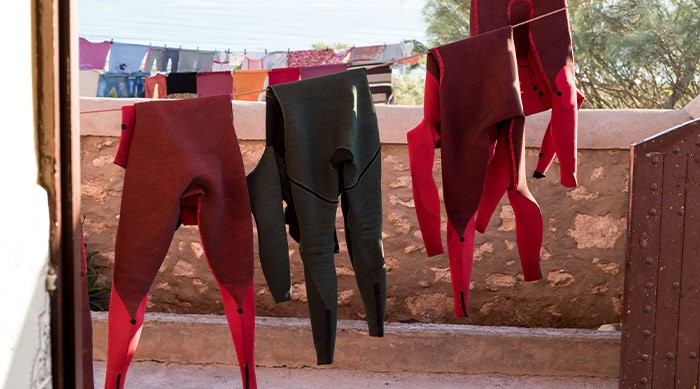How To Repair A Wetsuit

Your wetsuit will get flogged over time, it’ll take a proper beating while you’re using it non-stop in your pursuit to surf as much as you can. And like all things we use a lot, there’s a chance that something will happen to your wetsuit that will need repairing. Snagging a panel or seam on a fence, bounced off a sharp section of reef - wetsuits can get damaged from use. To help extend the life of your wetsuit (and stay warm) we’ve pulled together this helpful wetsuit repair guide.
Note: Before you undergo any wetsuit repair, check the status of your warranty – If your suit is damaged it may be covered under warranty so speak with your local shop or our customer service team before undertaking a repair to avoid you voiding the warranty. Reach out to the manufacturer (or check their website) for more information first.
What Can Be Repaired?
Like some of our clothing, patching a wetsuit can prolong the suits lifespan. and if you can manage to do a good job there’s a chance you won’t even notice the repair as you use the suit again. Of course, it’s much easier to fix a small tear than a larger hole, so if you notice a tear in your suit you should aim to fix it as soon as you can.
Unfortunately, not all repairs can be done at home or by yourself. If your wetsuit has a major rip that’s greater than five inches, a complete shearing of a zippers teeth, or an arm or leg ripping all the way off, are all major repairs that are best left to the professionals.
Before You Start Your Wetsuit Repair

Before starting on your journey as a wetsuit repairer, here’s a few basic things to tick off before you roll your sleeves up and get stuck into it.
• Thoroughly clean your wetsuit – ensure the repair area is clear of any sand build up and salt residue.
• Dry your wetsuit – Wet or damp neoprene isn’t friendly to adhesives and will only create more work.
• Assess the fix – Any rips on your wetsuit longer than four to five inches might require help from a professional
• Let your suit dry – Dry your suit both inside and out after you’ve located the area in need of repair.
• Gather your wetsuit repair kit – its go time.
Wetsuit Repair Kit: The Tools You’ll Need for the Job
We’re working with some chemicals here, so first up make sure you’re set up in a well-ventilated area with plenty of light as you’ll be working with neoprene cement (also known as neoprene glue). One thing to ensure you avoid is direct sunlight as wetsuits and UV rays don’t go well together but direct sunlight will also make the glue set quicker.
Now you can get your wetsuit repair kit together. Here’s a list of what you’ll need to have on hand to fix a rip in your wetsuit:
• Neoprene glue – There's various types of adhesives for neoprene available, and they all do the job of helping sealing or joining neoprene. Pick up a tube at your local surf shop or hardware store.
• Rubber gloves – A must have to keep your hands clean when working with neoprene glue.
• Paintbrush – To ensure precision when spreading the glue. Look for a brush that's as fine as possible, this will help avoid spreading any unnecessary excess around the repair area.
• Heavy round weight – These will help keep things in place and makes applying the neoprene glue onto the split much easier.
• Nylon string – Nylon string is much easier to work with on neoprene and stronger than normal thread. You'll need a small spool for any minor tears or splits to patch up.
How to Patch and Sew a Wetsuit
• Hold the tear of your wetsuit open using the weights. This will help applying the adhesive ensuring a better bond isn’t maintained.
• Apply the first layer of neoprene glue along the inside edge. Its crucial to keep the weights in place to hold the tear apart so the two edges don’t touch just yet.
• After about five minutes, apply a second layer of neoprene glue using just enough to coat the tears surface. Using a fine brush on this will make life easier and reduce overuse of the adhesive.
• After another five minutes you can carefully remove the weights. Take your time doing this as you carefully and slowly re-join the tear.
• Once the tear is re-joined, gently press the torn edges together for a further minute or until it feels as though the glue has taken hold.
• Leave the wetsuit for at least an hour to make sure your fix is solid.
• Leave your wetsuit for an hour or so to ensure the fix is solid. If the tear has gone right through, turn the wetsuit inside out and repeat the steps.
• Finish up the repair by applying a thin layer of neoprene over the repaired surface on the outside of the wetsuit.
• Let the adhesive dry for at least an hour and you’re good to go. The longer you leave the adhesive to set, the better.
Need to Patch a Big Rip in Your Wetsuit?
Note: For tears larger than five inches it’s best to consult your local wetsuit repair professional
If you’ve unfortunately ripped your wetsuit and now have a decent sized tear bigger than five inches and you want to fix it yourself the below information should be helpful (again, it can be better to take it to a professional to get a large hole fixed).
• For anything between two-five inches, grab a sewing needle and some nylon string.
• Any rough or loose edges around the tear will need to be cleaned up with scissors.
• Thread your needle and position the suit in the most comfortable position for you to stitch it up.
• Starting at the narrower end of the rip, cross stitch all the way across keeping an even spacing and tension between stitches. Think of it like lacing up a shoe – keeping even spacing and tension between stitches.
• Tie off a knot at the end of your stitch and give it a tug to make sure it’s sturdy.
• Finally, apply an additional coating of neoprene glue on both sides to reinforce the repair.
A Clean Zipper is a Happy Zipper

One of the bigger frustrations with zippers is when they stop working due to sand, salt or just broken teeth. For something so sturdy and important to the functional use of your wetsuit you could be forgiven for thinking you don’t need to look after it. But you do, and the best way to keep your zipper in working order is to keep it clean and rinse it regularly with fresh water.
If your zipper feels a little sticky or isn’t gliding smoothly, than you could try using some zipper lubricant. Ideally using a wax-based lubricant like a boat zipper wax work the best as they’re formulated to be used in and around saltwater and they’re biodegradable
If unfortunately, your zipper is completely blown out or failed, it’s best to take your wetsuit to a professional wetsuit repair service. If you are at this point, make sure your suit is clean, dry and doesn’t stink before any repairs are started. Don’t forget to check your warranty status as you might be able to get the manufacturer to fix it for you.







